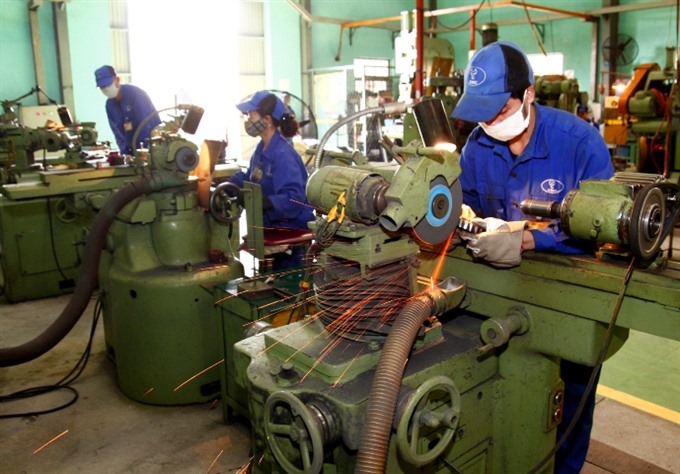 Society
Society

Diagnoses of occupational diseases are on the rise in Viet Nam, according to the Ministry of Labour, Invalids and Social Affairs (MOLISA).
 |
| Mechanic workers at the Export Mechanical Tool Joint Stock Company in Hà Nội. — VNA/VNS Photo Ngọc Hà |
HÀ NỘI — After two years of working at a factory in Ha Noi, mechanic Huỳnh from the central region finds it hard to hear conversations unless his companions talk loudly.
Although he hasn’t yet reached 30, Huỳnh has been diagnosed with severe hearing loss due to exposure to industrial noise, which can lead to deafness if not treated properly.
Diagnoses of occupational diseases are on the rise in Viet Nam, according to the Ministry of Labour, Invalids and Social Affairs (MOLISA).
Several new occupations have been found to cause respiratory diseases and deafness, MOLISA said.
Some 157,000 labourers in 42 localities had occupational diseases by the end of last year. Occupational deafness was detected in 64.4 per cent of the labourers, followed by silicosis (10.2 per cent), and occupational chronic bronchitis (5.1 per cent).
Reports from 57 localities who medically examined 1.2 million labourers showed high percentages of respiratory diseases (25.6 per cent of the total number of patients), digestive diseases (16 per cent), and musculoskeletal diseases (8.3 per cent).
38-year-old Nguyễn Ngọc Bảo in Biên Hòa City recently lost 11 per cent of his hearing after 20 years working at a steel production company in the Biên Hòa 2 Industrial Park.
Despite having tinnitus prior to discovering the illness, Bảo thought it was not serious and continued working.
Bảo’s illness could have been detected earlier if he had got an annual health check, said doctor Nguyễn Thị Thu Sang, head of the Occupation Disease Department at the Đồng Nai Centre for Occupational Health and Environment Protection.
Most workers do not get health checks until their illness is serious because they are not aware of the risks of the occupational diseases they face, according to Sang.
Some are willing to take their chances in exchange for high salary and good benefits.
It is difficult for medical units to conduct periodical health checks on factory workers if their employers are not willing to help, according to Sang.
“Factories and enterprises are not paying enough attention to work safety and haven’t enforced the use of work safety equipment such as earplugs and masks,” she told Đồng Nai online newspaper.
Some enterprises chose to take their employees to cheap medical facilities instead of those equipped with modern equipment and skilled staff, which reduces the quality of health checks, she said.
Survey results from the HCM City Public Health Institute on 1,000 tailoring factory workers show that 93 per cent feel exhausted after work, 47 per cent have experienced body fatigue, 15 per cent are burnt out, and some 80 per cent have musculoskeletal pains.
However, less than 10 per cent of workers who were surveyed had received healthcare, the results show.
Representatives from the Ministry of Health (MoH) said not enough attention had been paid to ensuring work safety and providing healthcare for labourers.
Limited awareness of both employers and labourers of work safety and hygiene, as well as limited financial resources, are some reasons for poor prevention of the diseases, the MoH said.
Some 2.3 million work-related deaths occur worldwide every year, two million of which are caused by occupational diseases, according to statistics from the International Labour Organisation (ILO).
Occupational diseases haven’t caught as much public attention as labour accidents although they cause six times as many deaths, according to the ILO.
The organisation called for an “urgent and strong” global campaign to prevent the rise of occupational diseases last month. — VNS




